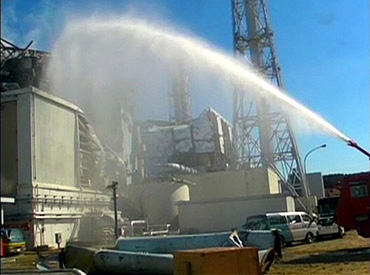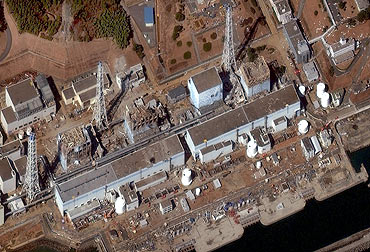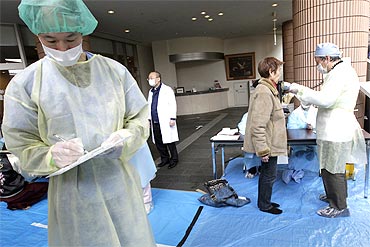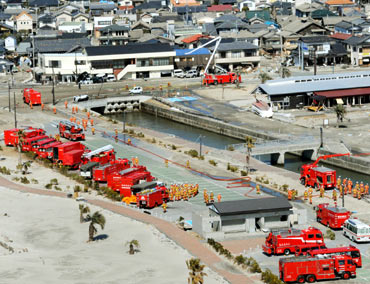 | « Back to article | Print this article |
Engineers close to restoring power at Fukushima
Japanese engineers on Saturday inched closer to connecting power at the tsunami-crippled Fukushima nuclear plants, north of the Japanese capital, so as to restore the damaged cooling system to the dangerously overheated nuclear fuel.
The Tokyo Electric Power Co, which owns and runs the plants, has stepped up efforts to bring electricity back to its crippled nuclear reactors to cool down the overheating spent fuel, as firefighters said they were increasing the spraying of water at the plant in a desperate attempt to avert a meltdown.
Connecting a power line to the no 2 reactor of the Fukushima Daiichi power plant is expected to be completed during the day, Kyodo news agency said. Engineers have now connected a power cable to the outside of the plant. Further cabling is under way inside to try to restart water pumps in four of the six reactors, the BBC said.
"We are scheduled to restore electricity at number 1 and 2 [reactors] on Saturday," an official of the nuclear safety agency said. "Reactors number 5 and 6 also will be powered on the same day.
They are scheduled to restore power to number 3 and 4 on Sunday," the BBC quoted the official as saying. More than a week after a devastating earthquake and tsunami, the report said restoring a stable source of electricity is a key step to prevent further deterioration of the situation by cooling down the reactor cores or water in the spent fuel tanks.
Click on NEXT to read further...
Conditions of the reactors remain stable than expected
Defense minister Toshimi Kitazawa told a press conference that an examination showed the surface temperatures at the no 1 to no 4 reactors at 100C or lower and that their conditions remain stable than expected.
At a separate press conference, chief cabinet secretary Yukio Edano said the condition of the no 3 reactor has become relatively stable, following the water discharge and that the Self Defence Force is now preparing to spray water into the no 4 reactor to cool its spent fuel pool.
"We are trying to get things under control, but we are still in an unpredictable situation," he was quoted as saying by the Japanese news agency.
The accident severity level at the plant was raised from four to five on the 7-point international scale by Japan's Nuclear and Industrial Safety Agency, placing the crisis two levels below Ukrain's 1986 Chernobyl disaster.
After smoke was detected from the no 3 reactor building on Wednesday, the SDF, fire fighters and others have stepped up efforts to spray water at the damaged building so as to prevent radioactive release.
Tonnes of water have been used to douse overheating fuel rods in what the chief of the United Nations International Atomic Energy Agency (IAEA) has described as "a race against time" to prevent a major disaster.
Click on NEXT to read further...
Radiation not at a level that would affect health: Fire department
Meanwhile, a ground SDF helicopter flew over the troubled Daiichi plant on Saturday morning to examine the changes in temperatures at its reactors using thermography, the defense ministry was quoted as saying by Kyodo. The CH47 chopper also examined what effect the water sprayed on the reactor had in cooling the spent fuel pool, it said.
According to the Tokyo fire department, the dose that workers were exposed to so far was not "at a level that would affect health."
Experts say a surge in water temperature, usually to 40C, causes the water level to fall, exposing the spent nuclear fuel rods, which could then heat up further, melt and discharge highly radioactive materials in the worst-case scenario.
According to Tokyo Electric, the maximum earthquake intensity measured at the nuclear power plant was 507 gals at the no 3 reactor building, smaller than 600 gals the nuclear plant is required to withstand.
Among the six reactors at the Fukushima Daiichi Nuclear Power Station, the no 1, no 2 and no 3 reactors, the only ones operating at the time of the magnitude 9.0 quake, halted automatically, but the cores are believed to have partially melted as the reactors lost cooling function after the quake, Kyodo said.
It said the buildings housing the no 1, no 3 and no 4 reactors have been severely damaged, leaving fuel pools there uncovered, and the no 2 reactor's containment vessel suffered damage to its pressure-suppression chamber below.
Click on NEXT to read further...
The largest crisis ever: Japanese prime minister
The government has set an exclusion zone of 20-kilometer radius of the damaged plant, asking people within 20 to 30 km to stay indoors. The no 5 and no 6 reactors were under maintenance at the time of the quake. It is now possible for these reactors to cool spent fuel by circulating water in the storage pools, the report said.
Prime Minister Kan on Friday described the tragedy as "the largest crisis for Japan," but was confident that the country will overcome it.
More than a week after the tragedy, the number of dead and missing in the quake disaster exceeded 18,000 -- 7,197 deaths and 10,905 unaccounted for, according to the National Police Agency.
It said 3,090 bodies have been identified so far, of which around 1,550 have been handed over to their families.
Apart from search for the missing and recovery of victims' bodies, the authorities have focused their attention on creating livelihoods for the survivors with some 387,000 evacuees staying at 2,200 temporary shelters.
Construction of some 200 temporary housing units also started on Saturday in the coastal city of Rikuzentakata in Iwate Prefecture, which was severely damaged in the earthquake and tsunamis. "We need to go forward," Mayor Futoshi Toba was quoted as saying by Kyodo news agency.
The US, Australia and several European nations asked their citizens in Tokyo and the quake-hit northeast to leave. Since March 12, over 1,600 Indians have left for India amid the nuclear crisis triggered by the devastating earthquake and the tsunami.


